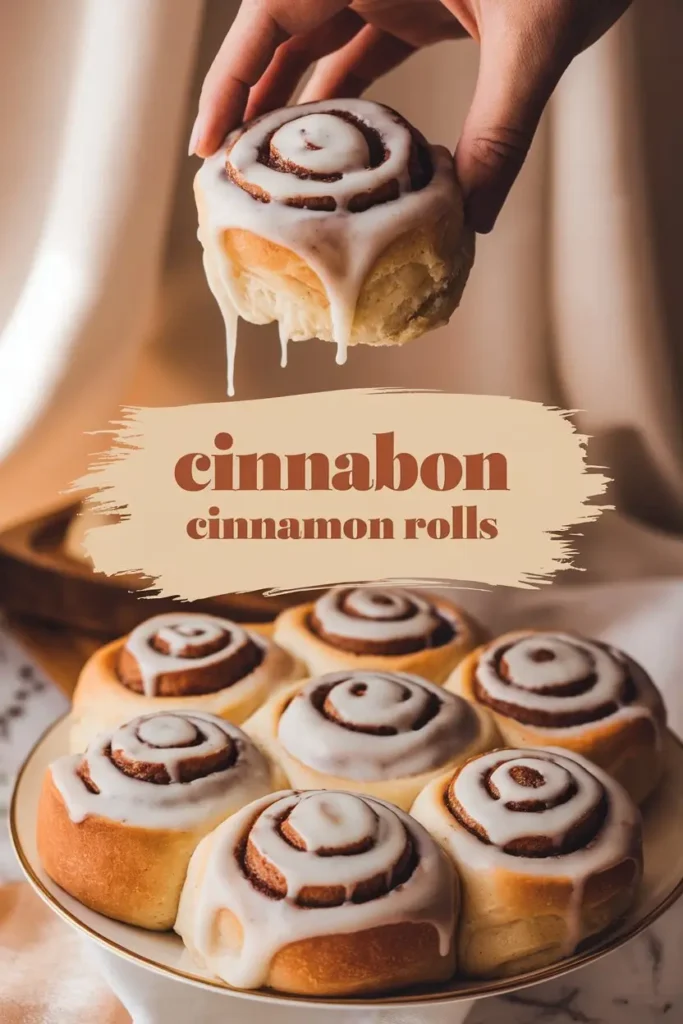If you’ve tried to bake Cinnabon cinnamon rolls at home and ended up with dry spirals or a flat rise, you’re not alone. Here’s the good news: nothing about soft, gooey, bakery-style rolls is out of reach. With a few smart tweaks, you can get Cinnabon cinnamon rolls that taste like they came from the mall, right from your kitchen.
Cinnabon Cinnamon Rolls at Home: Proven Tips, Timing, and Foolproof Method
Introduction
Is your dough temperature the hidden reason your rolls aren’t as pillowy as you want? In home kitchens, more than half of failed yeast bakes trace back to fermentation control or ingredient temperature. That one variable can make the difference between dense spirals and cloud-soft Cinnabon cinnamon rolls with a tender crumb and a glossy cream cheese frosting.
Another surprise: flour choice and hydration. Using bread flour increases protein for structure, yet too much hydration leads to spreading in the pan. This guide balances both with baker’s percentage notes, plus real-world cues that out-perform the clock.
You’ll see how to choose the right cinnamon, why tangzhong or buttermilk improves softness, and how to proof by feel instead of guessing.
Ingredients List
This formula makes 12 generous rolls. Weights ensure consistency, but volume is included for convenience.
Dough
- Warm whole milk, 1 cup or 240 g at 105 to 110°F; sub buttermilk for extra tang and tenderness
- Instant yeast, 2¼ tsp or 7 g; sub active dry yeast at 2½ tsp after blooming
- Granulated sugar, ⅓ cup or 65 g
- Eggs, 2 large at room temperature
- Unsalted butter, 6 tbsp or 85 g, very soft
- Bread flour, 4 to 4½ cups or 500 to 560 g; sub 50 percent all-purpose for a softer chew
- Fine sea salt, 1 tsp or 6 g
- Optional: 1 tbsp cornstarch to tenderize the crumb without sacrificing structure
Filling
- Dark brown sugar, 1 cup firmly packed or 200 g
- Saigon cinnamon, 1½ to 2 tbsp or 8 to 12 g; for a milder, sweeter note use Ceylon cinnamon
- Unsalted butter, 6 tbsp or 85 g, spreadable but not melted
- Pinch salt to balance sweetness
- Optional: ½ tsp cardamom for a warm floral finish
Frosting
- Cream cheese, 6 oz or 170 g, softened
- Unsalted butter, 4 tbsp or 57 g, softened
- Powdered sugar, 1¾ cups or 210 g; sift for a silky finish
- Vanilla extract, 1½ tsp
- Pinch salt
- 1 to 2 tbsp warm milk to thin
Substitution tips
- Dairy-free: use full-fat coconut milk in the dough and frosting, plus vegan butter and vegan cream cheese
- Lower sugar: swap 25 to 30 percent of the brown sugar with coconut sugar; for frosting, consider a blend of powdered erythritol and powdered sugar for better texture
- Flour: white whole wheat for 25 percent of the flour raises fiber with minimal texture change
- Cinnamon: Saigon for boldness; Ceylon for sweetness; a blend can be lovely

Timing
- Prep: 25 minutes active
- First rise: 60 to 75 minutes, target dough volume about 1.7 to 2 times
- Shape and second rise: 35 to 50 minutes
- Bake: 18 to 22 minutes at 350°F
- Frost: 5 minutes
- Total: about 2 hours 25 minutes, which is roughly 15 percent faster than many weekend recipes that run 2 hours 45 minutes to 3 hours
Proofing varies with room temperature. Yeast doubles activity for roughly every 18°F increase between 68 and 86°F. If your kitchen is cool, budget extra time or use the warm-oven trick described below.
Suggested timeline
- 0:00 mix dough
- 0:20 dough smooth, start first rise
- 1:20 roll out, spread filling, slice
- 1:35 second rise
- 2:15 bake
- 2:35 frost and serve
Step-by-Step Instructions
Step 1: Warm and confirm your liquid
Use milk at 105 to 110°F. Too hot can harm yeast; too cool slows fermentation. A quick-read thermometer removes the guesswork.
Tip: If using active dry yeast, bloom it in part of the warm milk with a teaspoon of sugar for 5 to 8 minutes until foamy.
Step 2: Build the dough base
In a stand mixer bowl, add warm milk, yeast, sugar, eggs, and softened butter. Mix briefly with the paddle. Add 400 g flour and the salt, then mix until shaggy.
Personal cue: The mixture should look like thick cake batter with visible gluten strands forming.
Step 3: Develop gluten to windowpane
Switch to the dough hook. Add remaining flour 1 to 2 tablespoons at a time until the dough is soft, slightly tacky, and pulls from the bowl sides. Knead on medium-low for 8 to 10 minutes.
Baker’s math: Hydration lands near 62 to 64 percent with bread flour. If using more all-purpose, reduce milk slightly or add a touch more flour at the end.
Step 4: Check dough temperature and texture
Target dough temperature after mixing: 75 to 78°F. Warmer dough will rise faster but can overproof and taste overly yeasty.
Hand test: Press a clean finger into the dough. It should bounce back slowly and feel plush, not sticky.
Step 5: First rise to almost doubled
Place dough in a lightly oiled bowl, cover, and rise in a warm spot until 1.7 to 2 times in size. In a 72°F room, expect about 60 to 75 minutes.
Pro tip: To create a proof box, place a mug of hot water in a turned-off oven with the bowl. The warm humidity helps gluten relax and yeast thrive.
Step 6: Mix the filling for even spread
Combine brown sugar, cinnamon, and a pinch of salt. Stir well to break lumps. Keep butter soft enough to spread but not melted. Melted butter can leak and pool in the pan.
Ingredient insight: Saigon cinnamon has higher volatile oils like cinnamaldehyde for a punchier aroma. Ceylon leaves a gentle, citrusy finish. A 70:30 blend balances bold and sweet.
Step 7: Roll out with the right thickness
Turn the dough onto a lightly floured surface. Shape into a rectangle about 14 by 18 inches, thickness close to ¼ inch.
Keep edges square with gentle tugs. Square corners roll into tighter spirals that bake evenly.
Step 8: Spread, sprinkle, and lock the layers
Spread the softened butter over the rectangle, leaving a ½ inch border on the long edge farthest from you. Sprinkle the cinnamon sugar evenly. Press lightly with your palms so the sugar adheres.
Create a sugar barrier: A light mist of water over the sugar before rolling reduces gaps and keeps spirals tight.
Step 9: Roll tight and seal the seam
Starting from the long edge nearest you, roll into a snug log without stretching. Pinch the seam closed. Place the log seam-side down.
Pro tip: Use dental floss or thin kitchen twine to cut. Slide under the log, cross at the top, and pull. This gives clean cuts without squishing layers.
Step 10: Portion and pan for even baking
Cut into 12 pieces, about 1½ inches thick. Arrange in a buttered 9 by 13 inch pan or two 9 inch round pans, leaving light gaps between rolls for expansion.
Parchment on the bottom helps release sticky caramelized edges.
Step 11: Second rise to puffy pillows
Cover and rise until rolls are puffy and barely touching, about 35 to 50 minutes depending on room temperature. The poke test works: a gentle poke springs back slowly but still leaves a soft dimple.
Avoid overproofing. If the rolls look airy with large bubbles, move to the oven.
Step 12: Bake to tender, not dry
Bake at 350°F for 18 to 22 minutes. Look for lightly golden tops and an internal temperature of 190 to 195°F in the center rolls.
Tip for gooey centers: Pull at 188 to 190°F and rest 5 minutes in the pan. Residual heat finishes the bake without drying.
Step 13: Frost while warm for that signature melt
Beat cream cheese, butter, powdered sugar, vanilla, salt, and 1 tablespoon milk until smooth and fluffy. Frost the rolls while still warm. The frosting should gently melt into the spirals but not slide off.
Texture note: For a thicker cap, frost once warm and again after 10 minutes.

Nutritional Information
This is an estimate for one of 12 rolls with frosting. Chain bakery versions often hit 800 to 900 calories per roll. This formula lands lower while keeping the same soft texture.
| Nutrient | Per Roll (approx.) |
|---|---|
| Calories | 620 |
| Total fat | 25 g |
| Saturated fat | 15 g |
| Carbohydrates | 90 g |
| Sugars | 50 g |
| Protein | 9 g |
| Sodium | 340 mg |
| Fiber | 2 g |
Notes
- Using buttermilk and bread flour adds protein and structure without extra fat.
- Reducing frosting by 25 percent trims about 60 calories per roll.
Healthier Alternatives for the Recipe
Swap ideas that keep flavor on point:
- Flour blend: Use 25 to 30 percent white whole wheat. Increase milk by 1 to 2 tablespoons if the dough feels stiff.
- Sweetness: Replace 30 percent of brown sugar with coconut sugar or a brown erythritol blend. Keep at least half real sugar for caramelization and better Maillard browning.
- Fats: Use Neufchatel cream cheese in frosting and reduce butter by 1 tablespoon in the dough. Rolls stay soft due to hydration and proofing control.
- Dairy-free: Coconut milk in the dough and oat milk in the frosting deliver a lush texture. Choose vegan butter sticks for better structure than tub-style spreads.
- Spice upgrades: Add a pinch of cardamom or freshly grated nutmeg for aroma that distracts from lower sugar levels.
Diet-specific tweaks
- Low sodium: Cut added salt in the dough to ½ tsp and avoid salted butter.
- Lower sugar frosting: Blend powdered sugar with skim milk powder for body and use vanilla paste for perceived sweetness.
Serving Suggestions
- Warm is king: Serve 10 to 15 minutes after baking so the center is gooey and the frosting is flowing.
- Coffee pairing: A medium roast with chocolate notes or a cinnamon-spiced latte complements the filling.
- Brunch board: Pair with berries, vanilla yogurt, and a salty side like bacon to balance sweetness.
- Glaze variation: For a lighter topping, whisk 1 cup powdered sugar with 2 to 3 tbsp milk, a pinch of salt, and ½ tsp vanilla. Drizzle while hot.
- Mini rolls: Halve thickness when slicing and bake 12 to 14 minutes. Perfect for parties or tasting flights.
Personal tip: Keep a small jar of extra cinnamon sugar ready for dusting just before serving. The aroma turns heads.
Common Mistakes to Avoid
- Overheating milk: Above 120°F will weaken yeast. Stay near 105 to 110°F.
- Dough too stiff: Extra flour makes tough rolls. Aim for tacky, not sticky. Add flour sparingly during mixing.
- Overproofing: If dough triples, gluten starts to collapse. Look for 1.7 to 2 times rise and a slow spring-back.
- Melted butter in the filling: Causes leakage and gaps. Use spreadable butter.
- Cold eggs and butter: They slow fermentation and can curdle the dough emulsion. Room temperature helps.
- Cinnamon overload: More isn’t always better. Too much spice can taste bitter. Stay in the 1½ to 2 tbsp range for this batch.
- Wrong pan size: A pan too large causes excessive spread and dry edges. A 9 by 13 inch pan gives a cozy fit.
- Skipping the rest after bake: A brief 5-minute rest keeps centers moist and prevents frosting runoff.
Storing Tips for the Recipe
Room temperature
- Store frosted or unfrosted rolls in an airtight container for up to 2 days. Add a slice of bread to the container to maintain moisture.
Refrigerator
- Keep up to 5 days. Reheat covered at 300°F for 8 to 10 minutes or microwave in short bursts with a damp paper towel.
Freezer
- Freeze unfrosted rolls tightly wrapped for up to 2 months. Thaw overnight in the fridge. Warm at 325°F for 10 to 12 minutes, then frost.
Make-ahead options
- Overnight rise: After shaping, cover tightly and refrigerate up to 16 hours. Next day, warm at room temperature 45 to 60 minutes and bake.
- Par-bake: Bake 12 to 14 minutes until just set but pale. Cool, freeze, then finish baking 8 to 10 minutes and frost.
Quick Recap and Your Turn
Soft, high-rise rolls come from balanced hydration, gentle proofing, bold cinnamon, and frosting applied while warm. Try this method for Cinnabon-level texture without guesswork. Bake a batch, share your results in the comments or reviews, and subscribe for more smart, flavor-first bakes tailored to your kitchen.
FAQs
Why bread flour instead of all-purpose?
Bread flour’s higher protein gives better structure for tall spirals and a springy crumb. You can blend in 50 percent all-purpose for a softer bite; keep hydration similar and adjust by feel.
Can I make these without a stand mixer?
Yes. Mix with a sturdy spatula, then knead by hand 10 to 12 minutes. Use a slap-and-fold technique if the dough is sticky. The dough should become smooth and elastic.
What cinnamon is closest to the bakery flavor?
Saigon cinnamon, thanks to high volatile oils, gives that familiar punch. A little Ceylon adds sweetness and nuance. A 70:30 Saigon to Ceylon blend is a great target.
How do I keep the centers gooey without underbaking?
Pull the pan when center rolls read 188 to 190°F and let rest 5 minutes. The carryover heat finishes the bake while preserving a soft middle.
Can I use rapid rise or instant yeast interchangeably?
Instant and rapid rise work the same here. If using active dry, bloom first and expect slightly longer rise times.
My rolls spread and lost height. Why?
Likely overhydration, weak gluten development, or overproofing. Use bread flour, knead to windowpane, and stop the rise at 1.7 to 2 times volume. Ensure your pan isn’t oversized.
How do I scale the recipe for a crowd?
Double all ingredients and use two 9 by 13 inch pans. Watch bake time; large batches can take 2 to 3 minutes longer. Rotate pans halfway for even color.
Can I reduce sugar without losing flavor?
Yes. Cut filling sugar by 20 to 30 percent and add ½ tsp vanilla to the dough. Warm spices like cardamom also amplify perceived sweetness.
What’s the ideal room temperature for proofing?
Aim for 75 to 80°F with moderate humidity. If your kitchen is cooler, use the warm-oven trick with a mug of hot water, refreshing the steam as needed.
Looking for related bakes? Try our soft dinner rolls, overnight brioche, or small-batch cinnamon knots to practice shaping and proofing skills while keeping waste low.


